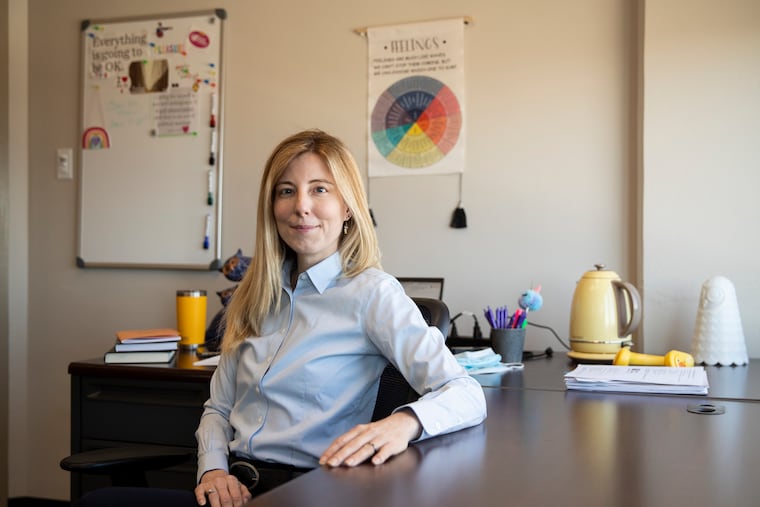Porn Studies class at Temple investigates ‘the other sex ed’
In Jenn Pollitt’s new class, students study the implications of digital porn.

The students in Temple University’s first-ever porn studies class arrived with memories of sex education that ranged from paltry to awkward to outright bizarre.
Francesca Ward, 21, recalled a teacher casually handing out ping-pong balls to the girls in her class in order to explain it was very easy to be date-raped with the drug GHB. Sarah Brenton, 26, remembered watching what seemed to be a Hallmark video about statutory rape and being told not to have sex, “but if you do, it should only be with someone your age.”
“Porn was definitely my sex education,” said Brenton, who grew up in Bucks County and said she first visited the website Pornhub surreptitiously on her iPod Touch in eighth-grade science class. In lieu of comprehensive education, she and others she knew turned to the internet.
Now she is back in the classroom to study that “other sex education,” online porn, in a new gender, sexuality, and women’s studies course at Temple.
The class aims to examine what messages about sex and culture viewers take away from porn, and look critically at how porn is discussed in both pop culture and scholarly research.
On a recent evening, about 40 students in the full-capacity class discussed Section 230 of the Communications Decency Act, which provides legal immunity to online platforms like Pornhub and Facebook, and debated the merits of the new Netflix documentary Money Shot: The Pornhub Story. In past classes, they heard from local sex educators about “purity culture,” studied the pre-internet history of U.S. obscenity laws, and read texts ranging from Jennifer Nash’s The Black Body in Ecstasy to Sonya Renee Taylor’s The Body is Not an Apology.
“I am not pro-porn. I am not antiporn,” Jenn Pollitt, the Temple professor who designed the course, said in a recent interview in her office, which is adorned with pastel-colored ovaries, testicles, and penises hand-crocheted by a student. “We’re going to look at what the research actually says.”
The class does not include viewing porn — a choice Pollitt made both because of the subject’s general ubiquity (students could certainly find it for themselves if they wanted to) and also because such a screening might make the class even more of a target in the culture wars. Even so, after a university news release went out earlier this year, Pollitt said she received a small but dedicated stream of hate mail. The field of gender studies is more broadly under attack nationwide, with a bill in Florida seeking to ban degrees in the field entirely.
The field of porn studies is about three decades old, conceived partly in response to the growing and highly profitable porn industry, as well as the broader academic push to rigorously study gender and pop culture. In 2014, porn scholars welcomed their first international peer-reviewed journal, Porn Studies. (A recent article: “Local flavour, film fantasies and shifting selections: Finnish sex magazines, 1972—1973″). From its inception, porn studies has often been greeted by nonacademics with a mixture of intrigue and horror.
“May the winds of academic change quickly rid the university of this fad before lasting damage is done to its reputation,” read a 1999 editorial in the Hartford Courant about Wesleyan’s new class, “Pornography: Writing of Prostitutes.”
Over the years, a wide range of universities have hosted porn studies courses, including the Massachusetts Institute of Technology, Vanderbilt University, and Arizona State University.
Pollitt, who students call Dr. J, designed the course because she found herself confronting a series of provocative questions as a scholar of sex education in a country without any mandatory across-the-board sex education. As digital porn became increasingly popular, she wondered: Does it function as a sex educator? What does it teach? And how does it impact people’s real-life experiences with consent, desire, and pleasure?
The spring class is a companion to a fall course Pollitt designed about sex education. The spring class, Social Perspectives in Digital Pornography: The Other Sex Education, was initially designed to be a 25-person class, but Pollitt kept raising the cap to accommodate high student interest.
This semester’s students said they were grateful to get to think critically about ideas they had unintentionally ingested for years.
“Some folks are actually pretty comfortable talking about sex,” said Brenton, “but talking about porn, there seems to be a thin layer, or sometimes even more than a thin layer, of shame.”
Ward, who is from London and studying abroad for the year, said as a plus-sized person she was particularly excited for an upcoming lesson about how body size is portrayed in mainstream pornography. “It’s really interesting that we’re going to see it in an analytical way, and see the fetishization and the appreciation and the politics that goes into that,” she said. Her classmate, Jack, 23, who requested to be referred to by their first name for privacy reasons, agreed.
“We need some more objective research,” Jack said. “For that reason alone, it should have a place in the academy.”